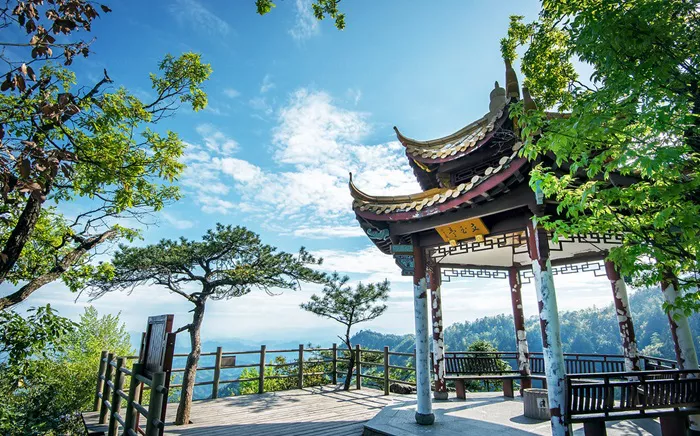Tianmu Temple is a famous Buddhist temple with a long history and deep cultural roots. It is known for its peaceful environment, beautiful temple architecture, and rich Buddhist traditions. Many visitors come to Tianmu Temple to seek spiritual guidance, enjoy nature, and learn about Buddhism.
Legends Surrounding Tianmu Temple
The Origin of the Temple’s Name
The name “Tianmu” means “Heavenly Eye.” According to legend, a sacred mountain near the temple has two peaks that look like eyes watching over the land. These peaks are believed to protect the people and bring blessings. The temple was built to honor this spiritual vision and connect heaven and earth.
The Story of the Sacred Monk
Long ago, a revered monk traveled through the area and meditated on the mountain. It is said that during his meditation, he experienced a divine vision. This vision inspired him to build a temple on the mountain to spread the teachings of the Buddha. The temple became a place for monks and laypeople to practice Buddhism together.
Miracles and Blessings
Many stories tell of miraculous events at Tianmu Temple. Visitors claim to have found peace, healing, and good fortune after praying there. The temple is especially famous for its buddhist temples healing powers and spiritual energy.
Geographical Location of Tianmu Temple
Where is Tianmu Temple Located?
Tianmu Temple is located on Tianmu Mountain, a scenic mountain range known for its natural beauty and rich biodiversity. The mountain is part of a protected nature reserve, making it an ideal place for quiet reflection and spiritual practice.
Natural Surroundings
The temple is surrounded by lush forests, clear streams, and peaceful walking paths. The fresh air and serene landscape create a perfect environment for meditation and relaxation. Visitors can enjoy beautiful views of the mountains and valleys from the temple grounds.
Accessibility and Nearby Attractions
Tianmu Temple is accessible by road and has well-maintained paths leading up to the temple buildings. Nearby, visitors can explore hiking trails, waterfalls, and other cultural sites. The temple area offers a chance to experience both nature and spirituality in harmony.
Visiting Tianmu Temple: A Guide for Pilgrims and Tourists
Best Time to Visit
The ideal time to visit Tianmu Temple is during spring and autumn when the weather is mild, and the natural scenery is most vibrant. During these seasons, the flowers bloom and the leaves change color, adding to the temple’s beauty.
What to Expect at Tianmu Temple
Visitors will find traditional temple architecture throughout the site. The buildings feature classic Buddhist styles, including elegant rooftops, intricate wood carvings, and peaceful courtyards. Each hall in the temple serves a different spiritual purpose, such as prayer, meditation, or study.
Dress Code and Etiquette
When visiting Tianmu Temple, it is important to dress modestly and respectfully. Visitors should remove their shoes before entering the temple halls and keep noise to a minimum to maintain the temple’s peaceful atmosphere. Photography may be restricted in some areas, so it is best to ask for permission.
Activities and Rituals
At Tianmu Temple, visitors can participate in various Buddhist practices such as chanting, meditation sessions, and offering incense. Many pilgrims come to light candles and pray for health, peace, and good fortune. The temple also hosts special ceremonies during important Buddhist festivals.
Facilities and Services
The temple offers facilities for rest and refreshment. There are quiet areas for meditation and study, as well as small shops selling Buddhist books, prayer beads, and souvenirs. Friendly monks and staff are available to guide visitors and answer questions about Buddhism and the temple’s history.
Understanding the Spiritual Significance of Tianmu Temple
The Role of Tianmu Temple in Buddhism
Tianmu Temple is more than just a tourist site. It is a living place of worship and learning. The temple plays an important role in preserving Buddhist teachings and practices. Monks here dedicate their lives to studying the Buddha’s words and helping others find the path to enlightenment.
Symbolism in Temple Architecture
The buddhist architecture at Tianmu Temple is full of meaning. Every detail, from the layout of the buildings to the decorations on the walls, represents Buddhist ideas. For example, the rooflines curve upward to symbolize reaching toward the heavens, while the statues remind visitors of compassion and wisdom.
Learning Buddhism at Tianmu Temple
Many visitors come to Tianmu Temple to learn about Buddhism in a direct way. The temple offers classes, lectures, and guided tours to explain Buddhist teachings clearly and simply. This makes it a perfect place for beginners as well as experienced practitioners.
How to Plan Your Trip to Tianmu Temple
Transportation Options
Travelers can reach Tianmu Temple by bus, car, or taxi from nearby cities. The roads are well maintained, and signs guide visitors toward the temple. For those who enjoy hiking, there are trails that lead up the mountain with beautiful natural scenery along the way.
Accommodation Near Tianmu Temple
Several guesthouses and small hotels are available near the temple for visitors who wish to stay overnight. These accommodations offer a peaceful atmosphere and easy access to the temple grounds.
What to Bring
Visitors should wear comfortable shoes for walking and bring water, especially in warmer months. Modest clothing is required, and a small notebook can be helpful for those who want to take notes during teachings or meditation sessions.
Conclusion
Tianmu Temple is a place where history, nature, and spirituality meet. Its legends inspire visitors, its location offers natural beauty, and its atmosphere invites deep reflection. Whether you are seeking peace, spiritual growth, or simply a beautiful place to visit, Tianmu Temple welcomes all with open arms.

